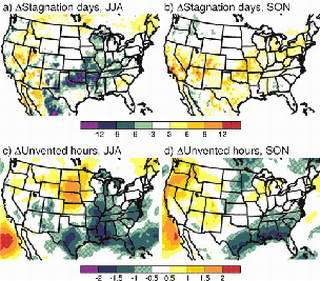Air quality in West going south

Texas air, already bad, will get a tad worse and Midwest air may actually improve, says EPA study of global warming on U.S. regional air quality.
By mid-century, air quality throughout the Western United States will deteriorate, according to a new EPA-funded computer simulation by the Pacific Northwest National Laboratory.
Image: STAGNATION NATION: A new computer simulation shows changes in stagnation in days per season (a=summer, b=fall) and the same for still-air "unvented" hours per day (c=summer, d=fall) based on the difference between the mean future (2045-2055) and control (1995-2005) regional climate simulations.
The model is among the first to project effects of future climate change on U.S. regional air quality, and they will be most dramatic in the West, this time of year. Come fall 2050, the model shows, a temperature increase of up to 4 degrees centigrade will contribute to a doubling of stagnant, bad-air days--from one week to two--west of the Rockies to the coastal mountains, said Ruby Leung, a fellow at the Department of Energy laboratory who led the study.
Bad air days are marked by "stagnation events," which occur when dry, windless air heats and fills with dust, ozone and other pollutants harmful to lungs and eyes. The model covers the period from 2045 to 2055, factoring in meteorological elements relevant to air quality--temperature, solar radiation and cloud cover, and two that control the rate at which polluted air is diluted or flushed from a locale, ventilation and stagnation. A known period, 1995-2005, was used for comparison.
The stagnation forecast in the West is limited to the fall, with no additional drop in air quality forecast for the summer, a finding similar to most other regions of the country. Summer, however, is the poor-air-quality season in Texas, and Texas will continue to warm by 2 to 3 degrees centigrade and to stagnate, by nearly four additional days at mid-century. Still, Leung reported, "it's not a large change compared to the average 15 days per season in the control simulation."
The Midwest stands out in glaring contrast. The model predicts increased cloud cover, which will in turn deflect the sun's rays back toward space, offsetting warming in the air near the surface for unchanged or even cooler temperatures than today. There will be less stagnation, up to 8 fewer days a season, and more frequent rainfall, as many as six extra days each season.
"Depending on the relative impacts of these parameters," Leung said, "ozone concentrations may remain similar or slightly decrease based on the simulated atmospheric changes alone." For more detailed projections of future air quality, Leung emphasized that "more studies need to be performed by including projections of natural and anthropogenic (human-produced) emissions and the complex chemical reactions that occur in the atmosphere."
Source: Pacific Northwest National Laboratory
















